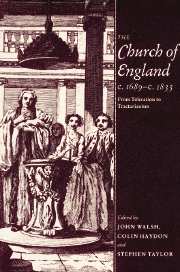Book contents
- Frontmatter
- Contents
- Preface
- List of Abbreviations
- 1 Introduction: The Church and Anglicanism in the ‘long’ eighteenth century
- Part I The pastoral work of the Church
- Part II Crisis and reform
- Part III Identities and perceptions
- 13 The eighteenth-century Church: a European view
- 14 Portrait of a High Church clerical dynasty in Georgian England: the Frewens and their world
- 15 ‘Papist traitors’ and ‘Presbyterian rogues’: religious identities in eighteenth-century Lancashire
- 16 Church parties in the pre-Tractarian Church of England 1750–1833: the ‘Orthodox’ – some problems of definition and identity
- Index
16 - Church parties in the pre-Tractarian Church of England 1750–1833: the ‘Orthodox’ – some problems of definition and identity
Published online by Cambridge University Press: 13 October 2009
- Frontmatter
- Contents
- Preface
- List of Abbreviations
- 1 Introduction: The Church and Anglicanism in the ‘long’ eighteenth century
- Part I The pastoral work of the Church
- Part II Crisis and reform
- Part III Identities and perceptions
- 13 The eighteenth-century Church: a European view
- 14 Portrait of a High Church clerical dynasty in Georgian England: the Frewens and their world
- 15 ‘Papist traitors’ and ‘Presbyterian rogues’: religious identities in eighteenth-century Lancashire
- 16 Church parties in the pre-Tractarian Church of England 1750–1833: the ‘Orthodox’ – some problems of definition and identity
- Index
Summary
‘It has been the fate of the Church of England from the beginning to be divided into parties’, observed J. B. Marsden in 1856 This was a view which squared uneasily with the assumption of many mid-nineteenth-century Churchmen and some later historians that party division within the Church of England was but one of the unwelcome legacies of the Oxford Movement after 1833. Moreover, the very idea of church parties and party spirit was widely portrayed as an unmitigated evil, redolent of sectarianism. However, long before Tractarianism's rise the assumed evil of party distinctions had become a subject of comment and concern. For instance. Richard Whately devoted the whole of his Bampton Lectures at Oxford in 1822 to warning against the consequences.
Whately's strictures on party feeling were based on the reality of contemporary divisions within the pre-Tractarian Church of England which could not only be traced back to the Reformation settlement itself but also had had a continuous existence since that era. Certainly, these divisions appeared to be more pronounced at some times than at others. Forinstance, the history of the Church of England during Queen Anne's reign notoriously was one dominated by party strife. In the subsequent Georgian epoch of supposed ‘moderation’ and somnolence, such divisions seem some what smothered. Nonetheless, party differences even then were not eradicated, and in the last decades of the century were reactivated.
- Type
- Chapter
- Information
- The Church of England c.1689–c.1833From Toleration to Tractarianism, pp. 334 - 359Publisher: Cambridge University PressPrint publication year: 1993
- 3
- Cited by



